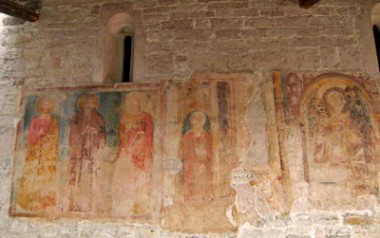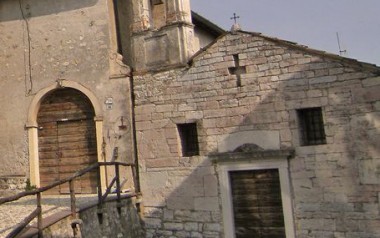Church S. Giacomo in Calino
The Garda tradition considers the church of San Giacomo one of the oldest in the lake, but the first attestations date back to 1194 and there are no traces of structures prior to the Romanesque phase.
The church of San Giacomo di Calino stands on the shore of the lake near a convenient landing point north of the center of Gargnano: here the Regia road coming from Salò was transformed into a mule track towards Muslone and Tignale and the church, with its portico on the southern side , had to perform a function of hospitality for travelers and pilgrims. In 1194 the ecclesia Calini is the place where the monastery of Santa Giulia collected the canons of some olive trees in the area: the choice of the delivery, not the landing as in Villa or Lovere of Gargnano, but in the church suggests a report of the latter with the Brescia monastery. The church has three main building phases: the nave and the southern portico constitute the oldest nucleus: in the fourteenth century the portico was enlarged and connected to the northern perimeter; subsequently, at the end of the sixteenth century, a new presbytery was built, which replaced the semicircular Romanesque apse, and the façade was transformed with the extension of the door and the opening of the two square windows. ……. The architectural site – which can be located by the middle of the 12th century – was completed by pictorial interventions that took place from the end of the century to the fourteenth century. Once the apse decoration has been lost, the portico preserves the oldest fragments: the San Cristoforo is the oldest painting, probably datable around the middle of the XIII century, with precise comparisons with the Veronese production of a more marked Byzantine-style accent. The painting is of undoubted quality and, despite the very degraded conditions, both the sure spatial orientation emerges (evident in the Child’s hand) , both the desire to create an image of strong devotional impact: the monumental frame of city towers and the complements in tablet and metallic sheet, of which clear traces are preserved in the stick of St. Christopher, were to give to those who approached the church, in particular from the lake the sensation almost of a numinous presence. A little later (late XIIIth – early XIVth century) it must have been the San Giacomo, in the north wall of the hall: A little later (late XIIIth – early XIVth century) it must have been the San Giacomo, on the north wall of the hall: the few fragments of what should have been a votive painting recall the dry and insistently graphic ways of the Romanesque decoration of the apse of the parish church of Manerba or the oldest part of the bell tower of San Francesco in Gargnano. The Verona area also includes the Three Saints (Antonio abate, Giacomo and an evangelist) painted on the external portico probably around the middle of the fourteenth century by a master of the Da Riva workshop, very active in the Lake Garda area in the second half of the fourteenth century. (G.P. Brogiolo)


